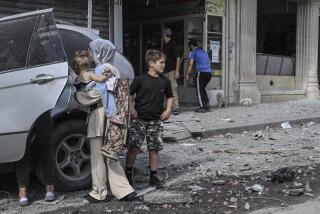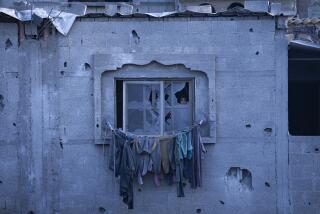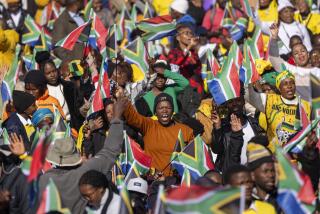Amid Joy, S. Africans Sadly Recall Victims of Violence : Society: Thousands of blacks and whites died in the 30-year struggle to end apartheid. Their survivors take comfort in knowing that the war is finally over.
- Share via
CAPE TOWN, South Africa — First there was the anger, white-hot and debilitating. Who could do such a thing? Then reason returned, and with it the quiet, dull pain of acceptance that has now lasted a decade.
Peter Younghusband’s son, Michael, was a 27-year-old civil engineer, doting father of an infant boy, and a white South African utterly indifferent to politics. Then he walked into an office elevator here, the doors closed, and he was blown apart by a bomb intended for government officials meeting nearly a dozen floors above.
Dorothy Petersen’s son, Hector, was a bright 13-year-old in a middle-class neighborhood of Soweto. One sunny morning, Hector kissed his mother goodby and headed for school. Minutes later, the black boy was shot dead by a white policeman trying to stop a peaceful student march.
Hector Petersen and Michael Younghusband, separated by 1,000 miles of South African soil, were just two of the tens of thousands of young men and women of promise who died in the cross-fire of the 30-year, tit-for-tat war between the African National Congress and the minority white rulers in Pretoria.
And this week, with the surprisingly peaceful transfer of power from white to black, families of those innocent victims were reminded of their losses--but also found comfort in the knowledge that the war between black and white has officially ended.
“It gives me a feeling of relief. You know it’s over, that this sort of thing is not likely to go on anymore,” said Peter Younghusband, a Cape Town writer and wine estate owner.
“I lost my son, and I’ve never held it against the ANC,” whose guerrillas planted the bomb in 1985, he added. “One of the things I came to accept was that I’m not the only one who has lost a son in this conflict. It happened on both sides.”
On that other side is Hector Petersen’s family. Hector’s sister, Antoinette Sithole, now 34, says it helps her to think that Hector’s death in 1976 was the beginning of the end of apartheid.
“These days I go to his grave and I tell him that things are changing in Africa, so he must rest peacefully now,” Sithole said. “I tell him that blacks can vote and we are looking at a really great future. I tell him that we are really grateful, although we miss him.”
Next month, on the anniversary of Hector’s death, his family will again visit the grave in Soweto’s Avalon Cemetery. In the early years, hundreds of anti-apartheid activists gathered at dawn at Hector’s grave site to commemorate the bloody student march in which he and several dozen others died. But over the years, the number has dwindled.
“This time I’m going to tell Hector that we have voted and we are so thrilled that we have a new government that is ours,” Sithole said. “We knew that one day we would get our freedom. But we really didn’t know how it was going to happen.”
There were no winners in the long war between the black oppressed and the white oppressors in South Africa. But there were many victims.
Some were innocent and unlucky bystanders who had been running an errand, going to school, taking a stroll, eating a hamburger, watching a rugby match or reading a newspaper when South Africa’s political turmoil detonated in front of them.
The ANC’s guerrilla war, born in the brutal police crackdown of the late 1950s, never came close to overthrowing the government or making the country ungovernable. But several hundred blacks and whites were killed by ANC car bombs, mines and hand grenades detonated at shopping malls, restaurants and military facilities during the 30-year war. And thousands of innocent blacks and whites were killed by police hit squads, riot police and government security forces.
Even so, the white minority government, although superior militarily, never came close to crushing the dream of black liberation. No matter how many blacks died at the hands of government security forces, more took to the streets. And the violence frightened away foreign investors, increasing pressure on Pretoria to talk to the ANC.
The campaign of armed resistance also gave the ANC substantial support in the seething black townships, where many angry residents embraced the ANC as their best hope for freedom from government repression.
“Even if it had very little effect militarily, it had quite substantial propaganda value for the ANC,” said Andre du Toit, a professor of political studies at the University of Cape Town.
Now, as the country looks ahead to the promise of racial peace and black empowerment, many thousands of black and white South Africans are trying to bury its painful memories and, as ANC leader Nelson Mandela and President Frederik W. de Klerk have done, shake hands with their former enemies.
Many of the people who killed, on both sides of the political divide, survived. Some in the ANC will be sitting in Parliament later this week. Others, who worked for the white government, have kept their jobs and their pensions. As De Klerk said in declaring a general amnesty for political crimes a few years ago, the country must learn to “forgive and forget.”
“Unfortunately, it’s too late for those who lost legs and arms, fathers and mothers,” said Ronel Greyling, a criminologist who worked with an organization, now disbanded, called Victims Against Terrorism. “In South Africa, it was always easier to kill someone than negotiate with them.”
For the Petersens, the memories are kept by one of the most famous photographs of the anti-apartheid struggle. It shows a limp Hector, still dressed in his school uniform of shorts and jacket, being carried through the streets of Soweto by another sobbing teen-ager.
On that day in 1976, Hector and Antoinette had gone to school only to find the streets filled with pupils protesting the use of Afrikaans, the language of the first white settlers of South Africa, as a medium of instruction in the schools.
When police fired tear gas and let dogs loose on the crowd, the sister and brother hid together behind a house. But when Antoinette turned around, her brother was gone. She saw him later, unconscious and mortally injured.
“I often wonder what would have become of Hector,” said his sister, who named her oldest son after him. “He was a shy person, very shy and quiet. I wonder if he would have gotten married by now.”
But it helps her to think of Hector as a hero in the liberation struggle. “Maybe if we hadn’t demonstrated in 1976, things would still be the same here,” she said. “And I think his blood has helped cleanse us of apartheid.”
The sharp pain of loss has faded for Peter Younghusband as well. It’s something he doesn’t like to talk about. But every step South Africa takes toward democracy reminds him of the son he lost.
“It’s one of those unfortunate things that each time I read about somebody else’s son being killed, I think about it,” he said. “It strikes a nerve every time.”
Younghusband has always considered the ANC’s protest to be justified, “although I haven’t always felt good about what they did.” The irony, though, was that his son was “totally nonpolitical,” the father said. “I used to say to him, ‘You should take more interest in what’s going on, because it affects you so much.’ ”
The day he was killed, Michael Younghusband took a national civil engineering exam and then stopped by his office to pick up some papers. The elevator bomb had been intended for a government meeting in the downtown building.
“The tragic thing about it . . . in a building where literally thousands of people work, (was) why him out of all these people?” Peter Younghusband said. “I’ve always felt he was a victim of a very tragic situation and a vicious system, which thankfully is coming to an end.”
The results of Michael Younghusband’s exam arrived after the funeral. His score was the highest in the country.
More to Read
Sign up for Essential California
The most important California stories and recommendations in your inbox every morning.
You may occasionally receive promotional content from the Los Angeles Times.











